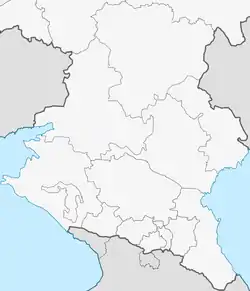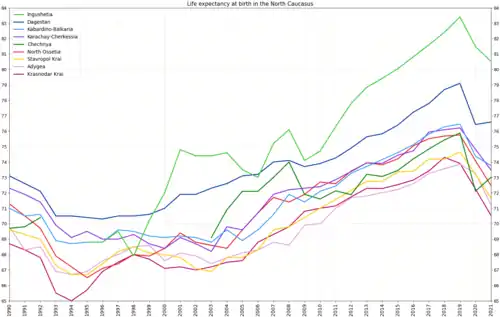North Caucasus
The North Caucasus,[lower-alpha 1] or Ciscaucasia (Russian: Предкавказье, romanized: Predkavkazye), is a subregion in Eastern Europe. It is the northern part of the wider Caucasus region, and is entirely a part of Russia, sandwiched between the Sea of Azov and Black Sea to the west, and the Caspian Sea to the east. The region shares land borders with Georgia and Azerbaijan to the south.[lower-alpha 2] Krasnodar is the largest city within the North Caucasus.

est-
an
rakh-
an
Oblast
- Red: NC economic region, former NC krai, former NC military okrug
- Green: former NC military okrug
- Blue: NC economic region, NC federal okrug, former NC military okrug
Politically, the North Caucasus is made up of Russian republics and krais. It lies north of the Main Caucasian Range, which separates it from the South Caucasus. As part of Russia, the territory falls within the North Caucasian and Southern Federal Districts and consists of Krasnodar Krai, Stavropol Krai, and the constituent republics, approximately from west to east: the Republic of Adygea, Karachay-Cherkessia, Kabardino-Balkaria, North Ossetia–Alania, Ingushetia, Chechnya, and Republic of Dagestan and to the north: Kalmykia.[1]
Geographically, the term North Caucasus also refers to the northern slope and western extremity of the Greater Caucasus mountain range, as well as a part of its southern slope to the West. The Pontic–Caspian steppe area is often also encompassed under the notion of "Ciscaucasus", thus the northern boundary of the Forecaucasus steppe is generally considered to be the Manych River. Owing to its mild climate compared to much of Russia, the region has been described as Russia's "sunbelt".[2]
History
Ancient cultures of the Northern Caucasus are known as Klin-Yar community, with the most notable culture being the ancient Koban culture. Other haplogroups were Haplogroup J1 and Haplogroup G-M285.[3]
Ciscaucasus was historically covered by the Pontic–Caspian steppe, mostly on fertile calcareous chernozyom soils, which has been almost completely tilled and grazed. It is bounded by the Sea of Azov on the west, and the Caspian Sea on the east. According to the Concise Atlas of the World, Second Edition (2008), the Ciscaucasus region lies on the European side of the "commonly-accepted division" that separates Europe from Asia.
The Northern Caucasus was conquered by Russia after the Russo-Circassian War. Much of the Northern Caucasus seceded from Russia in March 1917 as the Mountainous Republic of the Northern Caucasus, taking advantage of the instability caused by the February Revolution and becoming a minor participant in the Russian Civil War. Mountainous Republic troops engaged in fierce clashes against the invading White General Anton Denikin's Volunteer Army, before the latter's defeat at the hands of the Red Army. The region was informally occupied by the Soviet Union shortly afterwards, and the republic was forced into accepting a nonviolent annexation in January 1921. It was reformed into the Mountainous ASSR, which was later dissolved in October 1924, replaced by a series of autonomous Okrugs and Oblasts.
The outer border of the Soviet Union's North Caucasus Krai was the same as that of present-day North Caucasus Economic Region (Raion) which includes an oblast (Rostov Oblast), two krais (Krasnodar Krai and Stavropol Krai), and seven republics. The former North Caucasus Military District (Okrug) also included Astrakhan Oblast, Volgograd Oblast, and the Republic of Kalmykia. Its administrative center was Rostov-on-Don until 10 January 1934, Pyatigorsk until January 1936, then Ordzhonikidze (today Vladikavkaz) and, from 15 December 1936, Voroshilovsk (today Stavropol).
In June 2022, the US State Department advised citizens not to travel to the North Caucasus, including Chechnya and Mount Elbrus, due to terrorism, kidnapping, and risk of civil unrest.[4]
Gallery
 Location of the North Caucasian Federal District
Location of the North Caucasian Federal District Map of former North Caucasus Military District (okrug)
Map of former North Caucasus Military District (okrug) Map of modern-day North Caucasus Economic Region (raion)
Map of modern-day North Caucasus Economic Region (raion) Sophia Valley, Karachay-Cherkessia
Sophia Valley, Karachay-Cherkessia
See also
- Caucasus
- Confederation of Mountain Peoples of the Caucasus
- Dolmens of the North Caucasus
- Insurgency in the North Caucasus
- Kuban People's Republic
- Mountain Autonomous Soviet Socialist Republic
- Mountainous Republic of the Northern Caucasus
- North Caucasian Federal District
- North Caucasian Soviet Republic
- North Caucasus economic region
- North Caucasian Federal University
- North Caucasian Krai
- North Caucasian Military District
- North Caucasian Railway
- Southern Federal District
References
- "Russia: Protesters Ransack Government Building In Karachaevo-Cherkessia". RadioFreeEurope/RadioLiberty.
- Hill, Fiona; Gaddy, Clifford (2003). The Siberian Curse: How Communist Planners Left Russia Out in the Cold. Washington, D.C.: Brookings Institution Press. p. 121. ISBN 978-0-8157-9618-3.
“The North Caucasus region extends across Rostov oblast and Stavropol and Krasnodar krays. It also encompasses the seven autonomous republics of Dagestan, Chechnya, Ingushetiya, North Ossetiya, Kabardino-Balkariya, Karachayevo-Cherkessiya, and Adygeya. The region accounts for about 2 percent of the territory of the Russian Federation and in 1989 had a population of 13,183,860, or about 8 percent of the Russian population. The North Caucasus could qualify as Russia's "sunbelt."
- Boulygina, Eugenia; Tsygankova, Svetlana; Sharko, Fedor; Slobodova, Natalia; Gruzdeva, Natalia; Rastorguev, Sergey; Belinsky, Andrej; Härke, Heinrich; Kadieva, Anna; Demidenko, Sergej; Shvedchikova, Tatiana (June 1, 2020). "Mitochondrial and Y-chromosome diversity of the prehistoric Koban culture of the North Caucasus". Journal of Archaeological Science: Reports. 31: 102357. doi:10.1016/j.jasrep.2020.102357. ISSN 2352-409X. S2CID 218789467.
- "Russia Travel Advisory". travel.state.gov.
- "Демографический ежегодник России" [The Demographic Yearbook of Russia] (in Russian). Federal State Statistics Service of Russia (Rosstat). Retrieved July 17, 2022.
- "Ожидаемая продолжительность жизни при рождении" [Life expectancy at birth]. Unified Interdepartmental Information and Statistical System of Russia (in Russian). Retrieved July 17, 2022.
- "Russia: Mountain Air Leads To Long Life In North Caucasus". June 1, 2007.
- Sam Bedford (February 13, 2018). "Why the Caucasus Has So Many 100-Year-Olds". TheCultureTrip.com.
- Science (January 29, 2021). "The Caucasus. The Oldest People In The World (Episode 3). Full Documentary" (video). YouTube.
Notes
- (Adyghe: Темыр Къафкъас, romanized: Temır Qafqas; Kabardian: Ишхъэрэ Къаукъаз, romanized: İṩxhərə Qauqaz; Chechen: Къилбаседа Кавказ, romanized: Q̇ilbaseda Kavkaz; Russian: Северный Кавказ, Ossetian: Цӕгат Кавказ, romanized: Cægat Kavkaz, Ingush: Даькъасте, romanized: Däq̇aste, Karachay-Balkar: Шимал Кавказ, romanized: Şimal Kavkaz)
- The North Caucasus also shares borders with the two partially recognized breakaway states of South Ossetia and Abkhazia to its south, both of which are internationally recognised as part of Georgia.
Further reading
- In Quest for God and Freedom: Sufi Responses to the Russian Advance in the North Caucasus by Anna Zelkina
- Russia in the Modern World: A New Geography by Denis J. B. Shaw, Institute of British Geographers
External links
- History of the Caucasus
 Media related to North Caucasus at Wikimedia Commons
Media related to North Caucasus at Wikimedia Commons North Caucasus travel guide from Wikivoyage
North Caucasus travel guide from Wikivoyage- Relations between The North and South Caucasus. Articles in the Caucasus Analytical Digest No. 27
